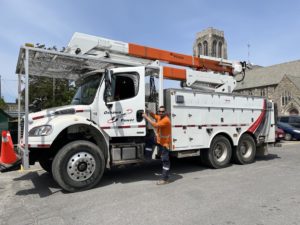Oshawa Power is dedicated to helping build the next generation of innovators across the power and utilities sector. Through our paid co-op and internship programs, we enable students from across Ontario to gain real world experience directly related to their area of study.
Whether the next generation of talent ends up at Oshawa Power or works elsewhere in the industry, we know that providing hands-on experience is key to solving the problems of tomorrow and building a sustainable electrical system.
We spoke to some of our students about their experience with Oshawa Power:
Jonel Reglos
B. Eng – Electrical Engineering at Ontario Tech University
Why did you want to join Oshawa Power for your co-op term?
I wanted to join Oshawa power in order to gain experience in the electrical utility sector. Beyond that, the City of Oshawa is continually expanding and I believed that I would be able to work on exciting projects that would help facilitate the City’s growth while learning more about the energy sector.
What is the biggest takeaway from your experience that will help you build your career?
At school, I learned more about theory, while here at Oshawa Power I am able to apply that theory and develop an in-depth knowledge about what goes on at an electrical utility. This knowledge has helped me build a foundation that will allow me to take the next steps in my career.
Do you have any tips for future generations of students at Oshawa Power?
Yes! Make the most of your experience at Oshawa Power. There is so much to learn and it is up to you, as an individual, to seek out and grasp that knowledge.
Rahman Mohammed
B. Eng – Electrical Engineering at Ontario Tech University
Why did you want to join Oshawa Power for your co-op term?
When it was time to start looking for co-op opportunities, I found that electric utilities are the best place to start for electrical engineering students. As a mid-sized LDC, I thought Oshawa Power would provide an exciting opportunity for cross-departmental learning and developing an understanding of the different day-to-day needs across both residential and commercial services.
What is the biggest takeaway from your experience that will help you build your career?
One of the biggest takeaways for me is just the understanding of how much goes into delivering electricity across the city. From transmission lines, to substations, and eventually the transformers at a smaller neighborhood level, it gave me a new perspective on how I view roads, neighbourhoods, and urban planning.
Do you have any tips for future generations of students at Oshawa Power?
Always ask questions! I found that asking questions when you are unsure goes such a long way. The people here understand that we are learning and are always open and respectful when it comes to answering our questions. Even if they didn’t know the answer, they would always point me in the right direction to find the person who could help me solve the problem.
Niranjan Shrestha
MASc – Electrical & Computer Engineering at Ontario Tech University
Why did you want to join Oshawa Power for your co-op term?
As an international student with an electrical engineering background, I had always wanted to gain experience at a power utility company in Canada. Oshawa Power stood out as a diversified and innovative company with a rich history. Having such a long history and still remaining at the forefront in innovation and renewable energy solutions, Oshawa Power stood out to me as a great place to acquire experience.
What is the biggest takeaway from your experience that will help you build your career?
With such supportive and helpful colleagues, I’ve learned that proper communication is so important within an organization. Effective communication with your colleagues, supervisors, managers, etc. is essential to gain a level of trust that allows work to be completed efficiently. Developing these communication skills make it easier to work with all kinds of people in order to work effectively.
Do you have any tips for future generations of students at Oshawa Power?
Be confident in the skills and knowledge that you already have. Try to leverage your experience in a way that is beneficial to both yourself and the company.
Thank you to this year’s group of co-op students for all of the amazing work they contributed to Oshawa Power. We are excited to see what the future has in store for this group of talented individuals.
Are you interested in experiencing our co-op program?
Head on over to our careers page to view current openings or join our Talent Network to stay in touch about future roles.

















